Chapter 5
A Nerd’s Guide to System Preferences
IN THIS CHAPTER
![]() Navigating System Preferences
Navigating System Preferences
![]() Locating specific controls
Locating specific controls
![]() Customizing Monterey from System Preferences
Customizing Monterey from System Preferences
Remember the old TV series Voyage to the Bottom of the Sea? You always knew you were on the bridge of the submarine Seaview because it had an entire wall made up of randomly blinking lights, crewmen darting about with clipboards, and all sorts of strange and exotic-looking controls on every available surface. You could fix just about anything by looking into the camera with grim determination and barking an order. After all, you were On the Bridge. That’s why virtually all the dialog and action inside the sub took place on that one (expensive) set: It was the nerve center of the ship, and a truly happenin’ place to be. Just like the bridge of your favorite starship from an entire host of TV shows and movies.
In the same vein, I devote this chapter to the System Preferences window and the most commonly used settings within it. After all, if you want to change how Monterey works or customize the features in our favorite operating system, you should head toward System Preferences. This one window is the nerve center of macOS and a truly happenin’ place to be. Sorry, no built-in wall of randomly blinking lights — but you do find exotic controls just about everywhere.
An Explanation — without Jargon, No Less
The System Preferences window, shown in Figure 5-1, is a self-contained beast. You can reach it in the following ways:
- Click the Apple menu (
 ) and choose System Preferences.
) and choose System Preferences. - Click the Time and Date display in the menu bar, and then choose Open Date and Time Preferences. In fact, you can also click most of the other menu status icons — including Bluetooth and Wi-Fi — and then choose Open Preferences.
- Right-click any uninhabited area of your Desktop and choose Change Desktop Background.
- Last, but not least, click the Launchpad icon in the Dock and then click the System Preferences icon (it looks like a collection of gears).
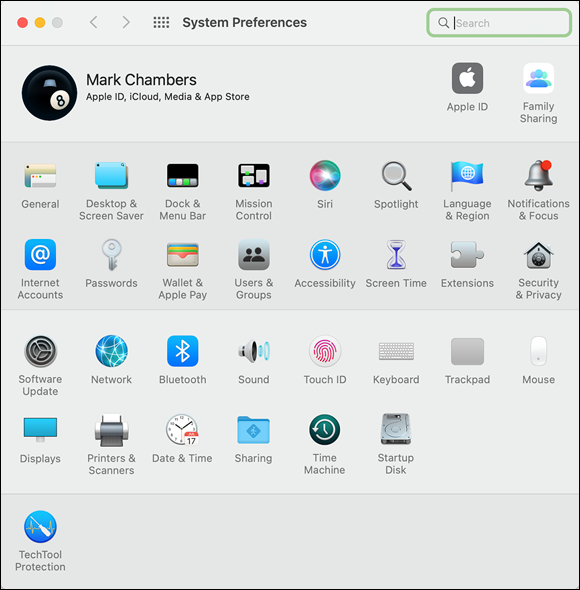
FIGURE 5-1: The powerhouse of settings and switches: System Preferences.
When the System Preferences window is open, you can click any of the icons to switch to that pane. The entire window morphs to display the settings for the selected pane. For example, Figure 5-2 shows the Sound pane, which allows you to set a system alert sound, configure your iMac’s built-in microphone, and choose from several different output options.
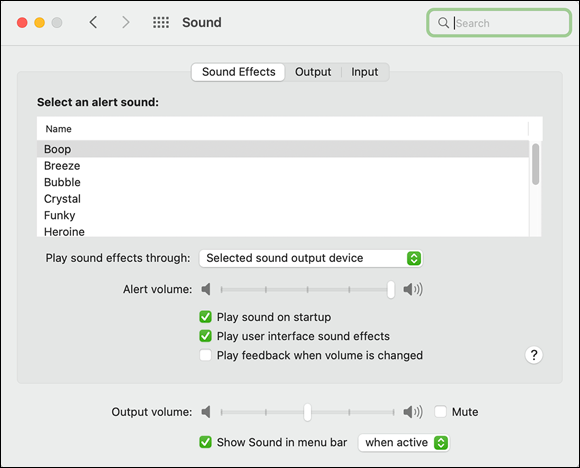
FIGURE 5-2: The Sound pane, proudly showing off the Sound Effects section.
Many panes also include a number of tabbed buttons at the top — in this case, Sound Effects, Output, and Input. You can click these tabs to switch to another section in the same pane. Many panes in System Preferences have multiple sections. This design allows our friends at Apple to group a large number of related settings in the same pane (without things getting too confusing).
![]() To return to the top-level System Preferences pane from any other pane, just click the Show All button (located in the upper-left corner of the pane) or press ⌘ +L. You can also click the familiar Previous and Next buttons to move backward through the panes you’ve already visited and then forward again, in sequence. (Yep, these buttons work just like the browser controls in Safari. Sometimes life is funny that way.)
To return to the top-level System Preferences pane from any other pane, just click the Show All button (located in the upper-left corner of the pane) or press ⌘ +L. You can also click the familiar Previous and Next buttons to move backward through the panes you’ve already visited and then forward again, in sequence. (Yep, these buttons work just like the browser controls in Safari. Sometimes life is funny that way.)
Although the System Preferences panes are arranged by category when you first install Monterey, you can also display the panes in alphabetical order. To arrange the panes in this way, choose View ⇒ Organize Alphabetically. Note that you can also select any pane directly from the View menu. Choose View ⇒ Customize, and you can hide specific icons from the System Preferences window. Just deselect the check box next to each icon you want hidden, and then click Done. You can still reach hidden icons from the System Preferences View menu, so they’re not banished forever.
You won’t find an OK button that you have to click to apply any System Preferences changes. Apple’s developers do things the right way. Your changes to the settings in a pane are automatically saved when you click Show All or when you click the Close button in the System Preferences window. You can also press ⌘ +Q to exit the window and save all your changes automatically. This is one of my favorite shortcuts.
Locating That Certain Special Setting
Wouldn’t it be great if you could search through all the different panes in System Preferences — with those countless radio buttons, check boxes, and slider controls — from one place, even when you’re not quite sure what you’re looking for?
Figure 5-3 shows exactly that kind of activity taking place. Just click in the System Preferences Spotlight Search box (located in the upper-right corner of the pane, with the magnifying glass icon) and type just about anything. For example, if you know part of the name of a particular setting you need to change, type that. Monterey highlights the System Preferences panes that might contain matching settings. And if you’re a switcher from the Windows world, you can even type what you might have called the same setting in Windows.
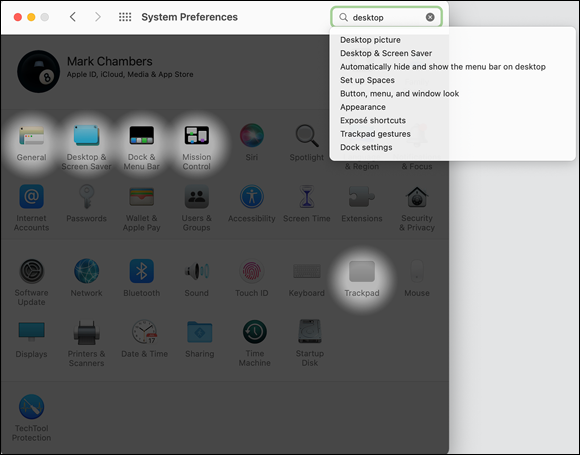
FIGURE 5-3: Searching for specific settings is a breeze with the Spotlight Search box.
The System Preferences window dims, and the icons that might contain what you’re looking for stay highlighted. Slick.
If you need to reset the Spotlight Search box to try again, click the X icon that appears at the right side of the box to clear it.
Popular Preferences Panes Explained
It’s time to get down to brass tacks. In this section, I take you through the most often-used panes in System Preferences to show what magic you can perform. I don’t discuss every pane, because I cover many of them in other chapters. In fact, you might never need to open some System Preferences panes, such as the Language & Region pane. This chapter covers just about all the settings you’re likely to use on a regular basis.
The Displays pane
If you’re a heavy-duty gamer, or you work with applications such as Keynote or Photoshop, you probably switch your monitor’s characteristics regularly. To switch easily, visit the Displays pane, shown in Figure 5-4. It includes these settings:
Resolution: To allow Monterey to choose the best resolution for your display, select the Default for Display radio button. To manually select a resolution, select the Scaled radio button, and then click the resolution you want to use from the Resolutions list that appears. In most cases, you want to use the highest resolution.
Move the Brightness slider to adjust the brightness level of your iMac’s display. If you like, you can enable the Automatically Adjust Brightness check box to allow your iMac to select a brightness level.
 Ready to stream content to your TV directly from your iMac — without cables? You can use Monterey’s wireless AirPlay feature to send the display from your desktop to your HD-TV. AirPlay requires an Apple TV unit that supports this feature. You can also send the audio from your iMac directly to an AirPlay-enabled receiver or speaker system. To make it easier to control AirPlay, open the Dock & Menu Bar pane in System Preferences and click the Screen Mirroring entry at the left; then click Show in Menu Bar check box. (Note that the icon will only appear in your menu bar when you have an Apple TV unit within range.)
Ready to stream content to your TV directly from your iMac — without cables? You can use Monterey’s wireless AirPlay feature to send the display from your desktop to your HD-TV. AirPlay requires an Apple TV unit that supports this feature. You can also send the audio from your iMac directly to an AirPlay-enabled receiver or speaker system. To make it easier to control AirPlay, open the Dock & Menu Bar pane in System Preferences and click the Screen Mirroring entry at the left; then click Show in Menu Bar check box. (Note that the icon will only appear in your menu bar when you have an Apple TV unit within range.)Color Profile: Click a display ColorSync profile from the drop-down list to control the colors on your screen. To load a ColorSync profile, click the Customize entry at the bottom of the list.
 You can also create a custom ColorSync profile and calibrate the colors that you see from the Customize list. Click the Add icon (which bears a plus sign) to launch the Display Calibrator Assistant. This easy-to-use assistant walks you step by step through creating a ColorSync profile matched to your iMac’s gamma and white-point values.
You can also create a custom ColorSync profile and calibrate the colors that you see from the Customize list. Click the Add icon (which bears a plus sign) to launch the Display Calibrator Assistant. This easy-to-use assistant walks you step by step through creating a ColorSync profile matched to your iMac’s gamma and white-point values.Night Shift: The Night Shift feature allows Monterey to automatically adjust your display to provide warmer colors during nighttime operation. Click Schedule to choose either Sunset to Sunrise operation or create your own custom schedule. You can also turn on Night Shift manually using the Turn On Until Tomorrow check box. Finally, adjust the Color Temperature slider to increase or decrease the warmth of colors on your display. The True Tone check box allows your iMac to automatically adjust your display colors to deliver the same tones under different lighting (such as a lamp you may turn on and off next to your keyboard).
 If you connect your iMac to one (or more) external monitors, don’t be surprised to see the Arrangement settings appear as well. You can drag the output to a different monitor, or drag the menu bar to another screen, or you can choose to mirror the same output to all displays connected to your computer. (And don’t forget, if you have an iPad running iOS 13 or later, you can use the Sidecar feature to turn that iPad into a second monitor — wirelessly! You’ll find more on Sidecar in Chapter 9.)
If you connect your iMac to one (or more) external monitors, don’t be surprised to see the Arrangement settings appear as well. You can drag the output to a different monitor, or drag the menu bar to another screen, or you can choose to mirror the same output to all displays connected to your computer. (And don’t forget, if you have an iPad running iOS 13 or later, you can use the Sidecar feature to turn that iPad into a second monitor — wirelessly! You’ll find more on Sidecar in Chapter 9.)

FIGURE 5-4: The Display pane makes it easy to change your screen resolution.
The Desktop & Screen Saver pane
No offense to the awesome Monterey coastline background, but what if you want to choose your own background? And what about adding a nifty Apple screen saver? You can change both the background and screen saver by using these options in the Desktop & Screen Saver pane.
The settings on the Desktop section, shown in Figure 5-5, are:
- Current Desktop picture: You can click a picture in the thumbnail list at the right half of the screen to use it as your Desktop background. The Desktop is immediately updated, and the thumbnail appears in the well (the upper-left box in Figure 5-5). To display a different image collection or open a folder of your own images, click the Add Folder button at the lower-left corner of the window (a plus sign) and browse for your heart’s desire; then click Choose to select a folder and display the images it contains.
- Layout: You can tile your background image, center it, fill the screen with it (cropping the edges if necessary), and stretch it to fill the screen (without cropping). Note that filling the screen in either case may distort the image. The layout pop-up menu appears only when you’re using your own pictures, so you don’t see it if you’re using a Desktop image supplied by Apple; instead, you see a drop-down list that allows you to choose a light or dark version of the Apple image.
- Change Picture: Change the Desktop background automatically after the delay period that you set, including each time you log in and each time your Mac wakes up from sleep mode.
Random Order: To display screens randomly, enable the Random Order check box. Otherwise, the backgrounds are displayed in the sequence in which they appear in the thumbnail list.
 The Dynamic Desktop selection automatically changes your desktop image based on the local time of day, offering you a subtle change in mood, as well!
The Dynamic Desktop selection automatically changes your desktop image based on the local time of day, offering you a subtle change in mood, as well!
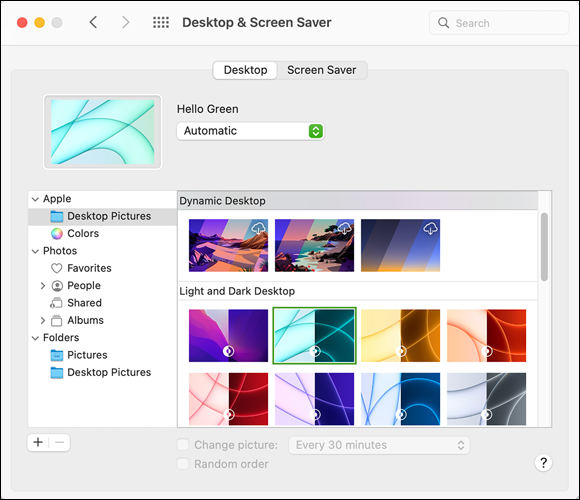
FIGURE 5-5: Pick your own Desktop background.
The settings on the Screen Saver section are:
- Screen Saver: In the Screen Saver list at the left, click any screen saver to preview (on the right). To try out the screen saver in full-screen mode, hover your pointer over the display on the right and click the Preview button that appears. (You can end the test by moving the cursor.) If the screen saver module you select has any configurable settings, click the Screen Saver Options button to display them. (A screen saver is not configurable if the Screen Saver Options button doesn’t appear.) Enable the Use Random Screen Saver check box to display a different screen saver module each time the screen saver is activated.
- Show Screen Saver After: Specify the period of inactivity that triggers the screen saver. To disable the screen saver, disable the check box. (Your Start After delay should be a shorter time than the Turn Display Off After delay you set in the System Preferences Energy Saver pane. Otherwise, you won’t see the great screen saver at all. I describe the Energy Saver pane later in this chapter.)
- Show with Clock: If you want your selected screen saver to display the time as well, select this check box.
Hot Corners: Click the Hot Corners button and then click any of the four pop-up menus in the four corners of the screen. Doing so designates that corner as an activation hot corner for several functions within Monterey. When you move your cursor to that hot corner, the function you specified is triggered automatically.
 For additional security, check out the Security & Privacy pane in System Preferences, where you find the Require Password After Sleep or Screen Saver Begins check box. When you select this check box, Monterey requires your user account password before allowing anyone to turn off the screen saver (a great idea in a secure environment, as you can imagine).
For additional security, check out the Security & Privacy pane in System Preferences, where you find the Require Password After Sleep or Screen Saver Begins check box. When you select this check box, Monterey requires your user account password before allowing anyone to turn off the screen saver (a great idea in a secure environment, as you can imagine).
Mission Control preferences
Figure 5-6 shows the Mission Control and Spaces settings that you can configure in this group. You can use Mission Control to view all the application windows you’re using at one time so that you can select a new active window. Or you can move all windows aside so that you can see the Desktop.
The settings are
- Automatically Rearrange Spaces Based on Most Recent Use: If this check box is selected, Mission Control presents your most recently used Spaces first in the thumbnails at the top of the screen.
- When Switching to an Application: When selected, this check box allows you to switch applications between Spaces desktops by using the ⌘ +Tab shortcut. Monterey jumps to the Desktop that has an open window for the application you choose, even if that Desktop is not currently active.
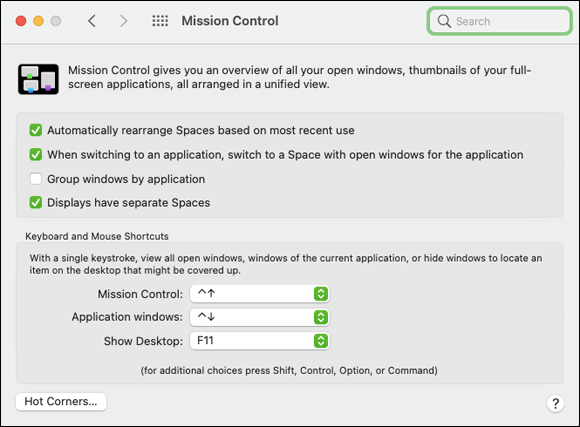
FIGURE 5-6: Set your Mission Control preferences here.
- Group Windows by Application: When selected, this check box automatically arranges windows in the Mission Control screen by the application that created them.
- Displays Have Separate Spaces: If you have multiple monitors connected to your Mac, you can select this check box to create a separate Spaces display for each monitor.
Keyboard and Mouse Shortcuts: From each pop-up menu, set the key sequences (and mouse settings) for Mission Control, Application Windows, and Show Desktop.
 You’re not limited to keyboard and mouse shortcuts in the pop-up menus. Press the Shift, Control, Option, and ⌘ keys while a pop-up menu is open, and you see these modifiers appear as menu choices! (Heck, you can even combine modifiers, such as ⌘ +Shift+F9 instead of just F9.)
You’re not limited to keyboard and mouse shortcuts in the pop-up menus. Press the Shift, Control, Option, and ⌘ keys while a pop-up menu is open, and you see these modifiers appear as menu choices! (Heck, you can even combine modifiers, such as ⌘ +Shift+F9 instead of just F9.)Hot Corners: Click the button at the lower-left corner of the pane to specify your hot corner settings. These four pop-up menus operate just like hot corners and active screen corners in the Desktop & Screen Savers pane, allowing you to control the operation of the screen management features within Monterey. Click one to designate that corner as one of the following:
- A Mission Control corner displays the Mission Control screen.
- An Application Windows corner displays only the windows from the active application.
- A Desktop corner moves all windows to the outside of the screen to uncover your Desktop.
- A Launchpad corner activates the Launchpad screen.
- A Notification Center corner displays the Notification Center strip at the right side of your Desktop.
Note that you can also set the Screen Saver Start and Disable corners from here, as well as put your display to sleep.
The General pane
The talented General pane, shown in Figure 5-7, determines the look and operation of the controls that appear in application windows and Finder windows. It looks complex, but I cover each option here.

FIGURE 5-7: Appearances might not be everything, but they’re easy to find here.
The settings are
- Appearance: Click the Light or Dark option to switch between Light or Dark mode for your Finder menu bar, window buttons and window background, and your Dock. You can also choose to hide the Finder menu bar. To display it while hidden, move your pointer to the top of the screen.
- Accent Color: Click an Accent color to use for buttons and menus.
- Highlight Color: Choose a color to highlight selected text in fields and pop-up menus.
- Sidebar Icon Size: Select the size of the icons in the Finder window Sidebar. It’s the strip to the left of the Finder window that displays your devices and favorite locations on your system. If you have a large number of devices, or if you’ve added several folders to the Sidebar, reducing the size of the icons allows you to display more of them without scrolling.
- Allow Wallpaper Tinting in Windows: When this check box is selected, macOS displays open windows with a tinted background when you’re using Dark mode. (The tint reflects the primary color used in your desktop background.)
- Show Scroll Bars: Specify when Monterey should display scroll bars in a window. By default, they’re placed automatically when necessary, but you can choose to display scroll bars always or only when you’re actually scrolling through a document.
- Click in the Scroll Bar To: By default, macOS jumps to the next or previous page when you click in an empty portion of the scroll bar. Select the Jump to the Spot That’s Clicked radio button to scroll the document to the approximate position in relation to where you click.
- Default Web Browser: Click this pop-up menu to specify which application Monterey should use to display web pages. By default, macOS uses the Safari web browser.
- Prefer Tabs: This setting allows you to specify when your applications should open documents in a new tab display or within a new document window. You can choose to use tabs always, only in full-screen mode, or only when you create a new tab in the application itself. (Note that if an application doesn’t support tab display, new documents open in a window.)
- Ask to Keep Changes When Closing Documents: If you select this check box, Monterey prompts you for confirmation if you attempt to close a document with unsaved changes. If the check box is deselected, Monterey allows the unsaved document to be closed without saving a new version.
- Close Windows When Quitting an App: If this check box is deselected, the macOS Resume feature automatically saves the state of an application when you quit. When you relaunch the application, Monterey restores all application windows and opens the documents you were working on when you quit. In effect, you can continue using the application just as if you had never quit. If you select the check box, Monterey does not restore your work, and you have to reload your document.
- Recent Items: The default number of recent applications, documents, and servers (available from the Recent Items item in the Apple menu) is 10. To change the default, open the pop-up menus here and choose up to 50. (I like 20 or 30.)
- Allow Handoff Between this Mac and Your iCloud Devices: If this check box appears within the General pane, you can enable it to turn on Handoff functionality within Monterey. (I discuss Handoff within the confines of Chapter 9.)
The Energy Saver pane
I’m an environmentalist — it’s surprising how many techno types are colored green — so the controls on this pane are pretty doggone important. When you use them correctly, you not only conserve power but also invoke the Power of Monterey to automatically start up and shut down your iMac whenever you like! (If you leave your iMac on for several days without a reboot, believe me: This is your Preference pane.)
To set a delay period for blanking your screen, drag the Turn Display Off After slider (shown in Figure 5-8) to the desired period. You can also power down the drive to conserve energy and prevent wear and tear (an especially good feature for magnetic hard drives).

FIGURE 5-8: Reduce your iMac’s power consumption from the Energy Saver pane.
The Dock & Menu Bar pane
I’ll come clean: I think the Dock is the best thing since sliced bread. (I wonder what people referred to before sliced bread was invented?) You can use the settings shown in Figure 5-9 to configure the Dock’s behavior until it fits your personality like a glove:
- Size: Pretty self-explanatory. Just drag the slider to change the Dock’s scale.
- Magnification: When you select this check box, each icon in the Dock swells like a puffer fish when you move the cursor over it. (The Magnification slider determines just how much it magnifies.) I really like this feature because I resize my Dock smaller, and I have a large number of Dock icons.
- Position on Screen: Select a radio button here to position the Dock on the left, bottom, or right edge of the Desktop.
- Minimize Windows Using: Monterey includes two cool animations that you can choose from when shrinking a window to the Dock (and expanding it back to the Desktop). Click the Minimize Windows Using pop-up menu to specify the genie-in-a-bottle effect or the scale-up-or-down-incrementally effect.
- Double-Click a Window’s Title Bar to Minimize/Zoom: Select this check box to minimize or zoom a Finder or application window by simply double-clicking the window’s title bar.
- Minimize Windows into Application Icon: If this check box is not enabled, minimized application windows appear as thumbnail icons on the Dock. To minimize application windows into the application icon on the Dock — which can save space on your Dock — select this check box. (To restore a window that’s been minimized into the application icon, right-click the icon on the Dock and choose Restore from the menu that appears.)
- Animate Opening Applications: Active souls who like animation probably get a kick out of the bouncing application icons in the Dock, which indicate that you’ve launched an application and that it’s loading. If you find this effervescence overly buoyant or distracting, deselect this check box.
- Automatically Hide and Show the Dock: Select this check box, and the Dock disappears until you need it. (Depending on the size of your Dock, the Desktop real estate you gain can be significant.) To display a hidden Dock, move the cursor over the corresponding edge of the Desktop.

FIGURE 5-9: Customize your Dock and Menu Bar with these controls.
- Show Indicators for Open Applications: macOS indicates which applications are running in the Dock with a small gray dot in front of the icon. To disable these indicators, deselect this check box.
- Show Recent Applications in Dock: Enable this check box to park the icons for the three applications you used last at the right side of the Dock (a real boon for those of us who use the same group of applications often). macOS automatically updates the three icons as you use your iMac.
- Automatically Hide and Show the Menu Bar: Like the Dock Hide and Show feature, you can select this check box to banish the Finder menu bar until you need it. To display the hidden menu bar, move your cursor over the top edge of your Desktop.
- Automatically Hide and Show the Menu Bar in Full Screen: Enable this check box to automatically hide the Finder menu bar while you’re using Full Screen mode.
Click any of the entries at the left of the pane to specify where you can quickly change settings for that feature from the macOS Desktop: the Control Center display; the Finder menu bar; or (with some entries) you can even choose both! Each entry has its own panel that appears, as well as a visual representation of the location and its appearance in macOS. Note that some settings can appear only in the Finder menu (like the icons for the Clock and Time Machine).
The Sharing pane
So you’re in a neighborly mood, and you want to share your toys with others on your local wired or wireless network. Perhaps you’d like to start your own website or protect yourself from the Bad Guys on the Internet. All these fun diversions are available from the Sharing pane in System Preferences, as shown in Figure 5-10.

FIGURE 5-10: Use controls on the Sharing pane to share your toys.
Click the Edit button to change the default network name assigned to your iMac during the installation process. Your current network name is listed in the Computer Name text field.
Each entry in the services list controls a specific type of sharing, including DVD and CD Sharing (if you have an optical drive, which I don’t, so this option is not shown in the figure), Screen Sharing, Media Sharing, File Sharing (with other Macs and PCs running Windows), Printer Sharing, Remote Login, Remote Management (using Apple Remote Desktop), Remote Apple Events, Internet Sharing, Bluetooth Sharing, Content Caching (which stores updates and other content for later installation), and AirPlay Receiver. To turn on any of these services, select the On check box for that service. To turn off a service, click the corresponding On check box to deselect it.
From a security standpoint, I highly recommend that you enable only the services you actually use. Each service you enable automatically opens your Monterey firewall for that service. Here’s a Mark’s Maxim to remember:
When you click one of the services in the list, the right side of the Sharing pane changes to display the settings you can specify for that particular service.
The Time Machine pane
iMac owners are thrilled with the Time Machine automatic backup feature that’s built in to Monterey. It’s saved all my stuff numerous times. You can easily configure how Time Machine handles your backups from this pane, as shown in Figure 5-11. Chapter 21 covers how to use Time Machine. Of course, you need an external drive (or an AirPort Time Capsule wireless backup device) for the best backup security. Note that Time Machine doesn’t work with a CD or DVD rewriteable drive; you must use an external drive, a Time Capsule device, or a high-capacity USB flash drive.

FIGURE 5-11: Put Time Machine to work, and your data is always backed up.
To enable Time Machine, click the Back Up Automatically check box to enable it, and then select a disk to hold your Time Machine backup data on the sheet that appears. (You can also switch backup disks at any time by clicking the Select Disk button.) Click Use Disk to confirm your choice — if you have an external Time Capsule wireless unit, click Set Up instead and follow the onscreen steps.
By default, Time Machine backs up all the drives on your system; however, you may not need to back up some folders on your iMac. (A good example is your iCloud Drive, which is already backed up to Apple’s iCloud servers.) To save time and backup drive space, Time Machine allows you to exclude specific folders from the backup process. Click Options, and then click the Add button (with the plus sign) to select the drives or folders you want to exclude. They appear in the Exclude These Items From Backups list.
Apple ID preferences
From the Monterey System Preferences Apple ID pane, shown in Figure 5-12, you can specify which types of data are automatically pushed to your iMac and iOS devices. If you haven’t created an iCloud account yet — or if you signed out of an existing account earlier — System Preferences prompts you to enter your Apple ID and password. Click Sign In to display the contents of the iCloud pane.
Click the iCloud entry at the left of the pane to display the check boxes for each category:
- iCloud Drive and iCloud Mail: From the iCloud Drive Options button, you can enable and disable iCloud Drive access for specific applications. If you’ve set up an iCloud email address, you can choose to access that email account on your iMac by enabling the iCloud Mail check box.
- Photos: Push the latest photos and video clips you’ve added in Photos to other devices, and update your Photos library with photos and video clips pushed from your iOS devices.
- Hide My Email: If you’re security conscious (good for you), this new feature makes it easy to create random email addresses that will forward messages to the email account of your choice, so your private email address remains private!
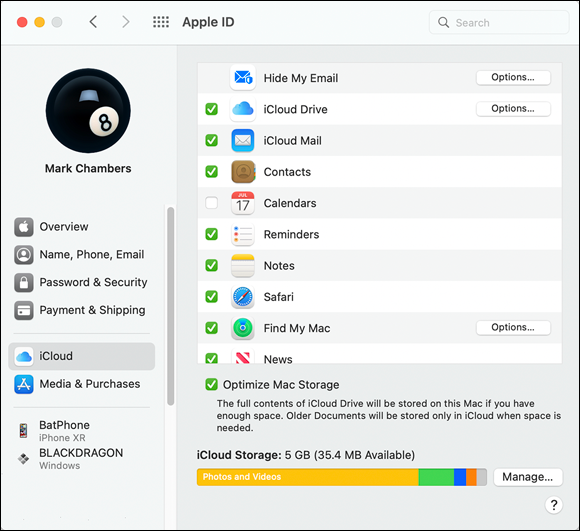
FIGURE 5-12: Control and configure your iCloud activity with these settings.
- Mail: Synchronize your Mail account settings between devices.
- Contacts: Push your Contact cards between devices.
- Calendars: Push your calendar events to and from your iOS devices.
- Reminders: Synchronize the reminders you’ve set between devices.
- Notes: Synchronize your Notes between devices.
- Safari: Synchronize your Safari bookmarks.
- Siri: Synchronize your Siri configuration.
- Keychain: Share passwords for applications and websites between your devices.
Find My Mac: Locate your iMac from a web browser or your iOS device. You can also choose to lock your computer remotely — or even wipe your iMac’s internal drive to prevent someone from stealing your data.
 Wiping your iMac remotely is a drastic step that will prevent you from locating it in the future.
Wiping your iMac remotely is a drastic step that will prevent you from locating it in the future.- News: Synchronize the articles you’ve read, articles you’ve saved, and sources you’re following in the News application.
- Stocks: Synchronize stocks that you’re following between devices.
- Home: Share video from a HomeKit-enabled camera between devices, using Monterey’s Home application.
- Siri: Synchronize your Siri configuration.
To display the storage currently being used by your mail, backups, documents, and application data, click the Manage button in the bottom-right corner of the pane. Apple provides each iCloud account with 5GB of space for free, but you can elect to buy additional storage from the Manage sheet.
Notifications & Focus preferences
The Notifications & Focus group is shown in Figure 5-13. When you select the Notifications tab, each application that can display notifications appears in the list at the left of the pane.
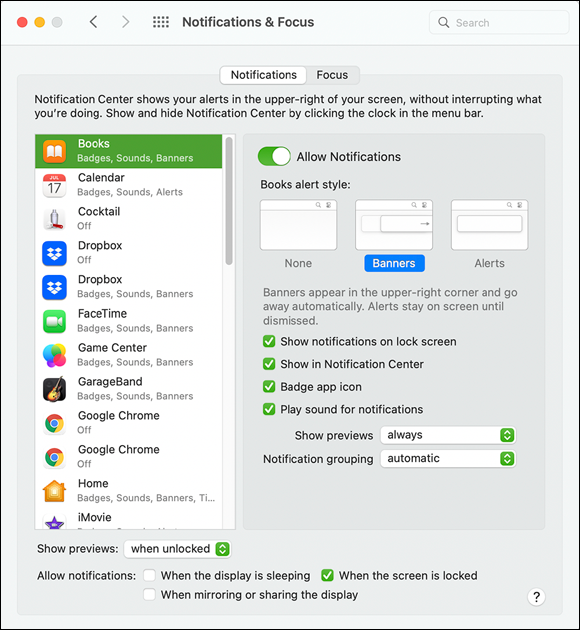
FIGURE 5-13: Each application that uses notifications can be individually configured.
Click an application in the list at the left to configure its notifications. Different applications display different options in the settings pane, but the settings can include the following:
 Alert Style: These three buttons specify which type of alert should appear under the Notification Center icon in the menu bar. You do not need to display Notification Center to see alerts, which appear on your Desktop. Choose None to disable alerts for this application. Choose Banners to display alert messages that automatically disappear after a delay. Choose Alerts to display alert messages that remain onscreen until you click the confirmation button in the Alert dialog.
Alert Style: These three buttons specify which type of alert should appear under the Notification Center icon in the menu bar. You do not need to display Notification Center to see alerts, which appear on your Desktop. Choose None to disable alerts for this application. Choose Banners to display alert messages that automatically disappear after a delay. Choose Alerts to display alert messages that remain onscreen until you click the confirmation button in the Alert dialog.- Show Notifications on Lock Screen: If it appears, you can select this check box to allow notifications even if your iMac is displaying the Lock screen.
- Show Notification Preview: If enabled, notifications for this application will include a preview of the content. You can also specify whether the preview will appear while your iMac display is locked.
- Notification Grouping: From this drop-down list, you can specify that multiple notifications from the same source are displayed by application or by automatic arrangement, or turn off grouping altogether.
- Show in Notification Center: To display notification messages from this application in Notification Center, select this check box.
- Badge App Icon: This check box toggles on and off the display of this application’s icon in alert boxes and in Notification Center. It also activates the numeric display of pending items on the icon itself (for example, unread mail and messages).
- Play Sound for Notifications: To play a sound when alerts appear, enable this check box.
Click the Focus tab to select which notifications are allowed for each Focus category, as well as devices that are automatically enabled within that Focus category. You can also create new Focus categories from this panel.

 Poking too many holes in your firewall is not A Good Thing.
Poking too many holes in your firewall is not A Good Thing.